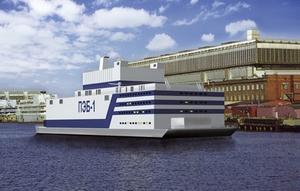Nuclear powerRussia to build floating nuclear power plants
Global warming is opening the Arctic Ocean to shipping – and causing the rapid melting of Arctic ice. Russia says that ship-based nuclear power plants would allow it to provide power to remote cities in Siberia, and provide power to oil and gas drilling operations in the Arctic (about 30 percent of the world’s unclaimed natural gas is in the Arctic, and about, 60 percent of that unclaimed natural gas is in the Russian Arctic). Experts worry about the ability of ship-based nuclear reactor to withstand extreme weather events, or terrorist attacks. The U.S. Army deployed its own floating nuclear reactor – the Sturgis – in the Panama Canal Zone from 1968 to 1976.

The Akademik Lomonsov // Source: wikipedia.org
Russian state-controlled energy company Rosatom is developing what maybe the future of portable energy: a ship-based nuclear power plant consisting of two small KLT-40 reactors,capable of generating seventy megawatts of electricity, enough to provide electricity, heat, and desalinated drinking water for a city of 200,000 people. The Akademik Lomonsov is a model for a new breed of mobile power plants that Rosatommay manufacture and export to other countries. The development of portable nuclear power at sea, however, is the result of Russia’s need for energy in oil and gas exploration in the Arctic. National Geographic reports that global warming is causing the accelerated melting of Arctic ice, offering access to 30 percent of the world’s unclaimed natural gas. About 60 percent of that unclaimed natural gas is in the Russian Arctic, home to four of the ten largest natural gas fields in the world, according to a U.S. Geological Survey estimate.
The Akademik Lomonsov will run on lightly enriched uranium to conform to International Atomic Energy Agency (IAEA) rules aimed at preventing fuel from being stolen and diverted for use in nuclear weapons. In a presentation to the IAEA, Rosatom confirms that the ship is designed to withstand magnitude 10 earthquakes, strong tsunamis, even a 10-ton aircraft crash. The ship is promoted as self-contained, being able to operate at locations far from centralized energy systems.
Rosatomenvisions that ships like the Akademik Lomonsov would “stimulate economic activity and maintenance of modern living conditions of the local population” in Russia’s Arctic and elsewhere. The Akademik Lomonsov will cost $340 million, according to World Nuclear News, and would be an ideal source of power for developing countries and remote towns and cities with energy needs.
Exporting portable nuclear power plants is a result of unexpected market forces for Rosatom, since its initial plan to develop the Akademik Lomonsov for Russia’s energy exploration has been derailed. Russian energy giant Gazprom ordered three floating power plants from Rosatomin 2008 to boost development of Arctic gas fields, hoping to export natural gas from the Arctic to the U.S. market. The shale gas revolution in the United States, however, has reduced the U.S. demand for natural gas imports, diminishing Gazprom’s interest in the ship-based power plants.
The National Geographic notes that both critics and supporters of nuclear power question whether the Akademik Lomonsov and similar ships will be able to perform in extreme weather, and whether they will become vulnerable to terrorist attacks. Ed Lyman, a physicist at the Union of Concerned Scientists (UCS), is concerned that the containment of the portable nuclear reactors might not be sturdy enough to withstand unforeseen dangers. “Fukushima has shown us that accidents can occur that we can’t predict very well,” he said. “We think that for the first generation, you need extra features to compensate for the things that you don’t know could happen.” Lyman also questioned the ability of the Akademik Lomonsov to operate for long periods of time using lightly enriched uranium rather than highly enriched uranium. “They’d have to refuel the power plant every three or four years,” Lyman said.
The idea of a floating nuclear plant is not new. The U.S. Army deployed a floating nuclear power plant on a barge, the MH-1A Sturgis, at the Panama Canal Zone from 1968 to 1976.
The U.S. military needed more sources of power in the Canal Zone because water used for hydroelectric power was instead diverted to accommodate the growing military traffic through the Canal Zone, the result of the intensifying Vietnam War and the closing of the Suez Canal.
When Jimmy Carter became president and began to negotiate the transfer of the Canal to Panama, the U.S. military became concerned about political unrest and violence in the Canal Zone, and the Sturgis was towed back to the United States, where it was battered and damaged by rough seas off the coast of South Carolina on the way to its final destination in Virginia. There were no radioactive leaks from the reactor.
The Sturgis was decommissioned in March 1977.
